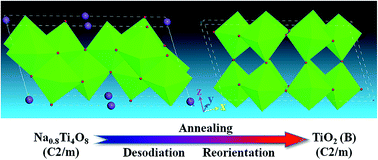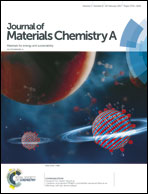Evidencing the structural conversion of hydrothermally synthesized titanate nanorods by in situ electron microscopy†
Abstract
Despite the high potential of using hydrothermal methods in the industrial production of TiO2 one-dimensional nanostructures (nanotubes, nanowires, etc.) for either environmental or energy applications, there has been much debate on the crystalline structure of the resultant hydrothermal product due to its weak crystallinity and small size. As a result, a range of titanates have been proposed as possible structures for the as-synthesized product. Herein, by using in situ transmission electron microscopy and a highly stable heating system, we microscopically explore the hydrothermally synthesized TiO2-derived single-crystal nanorods and their subsequent structural conversion upon annealing. In our case, a full set of evidence obtained from chemical, crystallographic, and valence state analyses suggests that the as-synthesized product possesses a Na0.8Ti4O8 structure, and undergoes a monoclinic-to-monoclinic transition (topochemical transformation) towards TiO2 (B) via desodiation and reorientation of TiO6 octahedra under constant heating. The as-observed kinetic restructuring process is further examined through density functional theory calculations, revealing the energy-favourable nature of the process. Such an observation at high spatial resolution demonstrates itself as an effective complement to conventional characterization methods, and may pave the way for large-scale synthesis of TiO2-based nanostructures.



 Please wait while we load your content...
Please wait while we load your content...